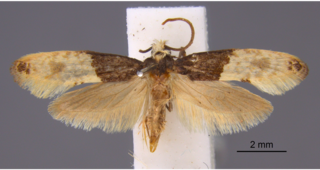
The silver-washed fritillary is a common and variable butterfly found over much of the Palearctic realm – Algeria, Europe and across the Palearctic to Japan.

The yellowspotted catshark is a rare catshark of the family Scyliorhinidae. It is found in the southeast Atlantic, from Lüderitz, Namibia to central Natal, South Africa, between latitudes 0° and 37° S. It can grow up to a length of about 1.22 metres. The reproduction of this catshark is oviparous.

One of the first shark species to be protected was the grey nurse shark. The biology, distribution and conservation of this species are dealt with in the following paragraphs with a main focus on Australia as it was here it first became protected.

Acronicta rumicis, the knot grass moth, is a species of moth which is part of the genus Acronicta and family Noctuidae. It was first described by Carl Linnaeus in his 1758 10th edition of Systema Naturae. It is found in the Palearctic region. A. rumicis lives and feeds on plants located in wide-open areas. At its larval stage, as a caterpillar, it causes such a large impact as a crop pest that it has received much attention and research. A. rumicis feeds on maize, strawberries and other herbaceous plants.

Epinotia ramella is a moth of the family Tortricidae. It is found in Europe, China, Japan, Russia and Kazakhstan.

Trichophaga tapetzella, the tapestry moth or carpet moth, is a moth of the family Tineidae. It is found worldwide.

Tinea pellionella, the case-bearing clothes moth, is a species of tineoid moth in the family Tineidae, the fungus moths. This species has a cosmopolitan distribution, occurring nearly worldwide.

Eriocrania unimaculella is a moth of the family Eriocraniidae found in Europe. It was first described by the Swedish naturalist Johan Wilhelm Zetterstedt in 1839. The larvae feed inside the leaves of birch, making a mine.

Muschampia proto, the sage skipper, is a butterfly of the family Hesperiidae. It is found in Morocco, Algeria, the Iberian Peninsula and southern France.

Elachista serricornis is a moth of the family Elachistidae found in Europe.

Phylloporia bistrigella is a moth of the family Incurvariidae. It is found in western, northern and central Europe and north-eastern North America.

Stenolechia gemmella is a moth of the family Gelechiidae. It is known from most of Europe

Coleophora siccifolia is a moth of the family Coleophoridae. It is found in most of Europe.

Elachista consortella is a moth of the family Elachistidae. It is found in most of Europe, except most of the Balkan Peninsula, Poland, Latvia and Finland.

Elachista cinereopunctella is a moth of the family Elachistidae found in Europe.

Heliozela resplendella is a moth of the Heliozelidae family. It is found from Fennoscandia and northern Russia to the Pyrenees, Alps and Romania and from Ireland to the Baltic region.

Carpatolechia notatella, the sallow-leaf groundling, is a moth of the family Gelechiidae. It is found in most of Europe and Turkey.

Acanthopsyche atra, the dusky sweep, is a moth of the family Psychidae. The habitat consists of heath and moorland.
Garrha carnea is a moth in the family Oecophoridae. It was described by Philipp Christoph Zeller in 1855. It is found in Australia, where it has been recorded from Queensland, New South Wales, Victoria, Tasmania and South Australia.

Psychoides verhuella is a moth of the family Tineidae found in Europe. It was first described in 1853, by Charles Théophile Bruand d'Uzelle from a specimen from Besançon, France. It is the type species of the genus Psychoides, also raised by Charles Bruand in 1853. The larvae feed on ferns.

















